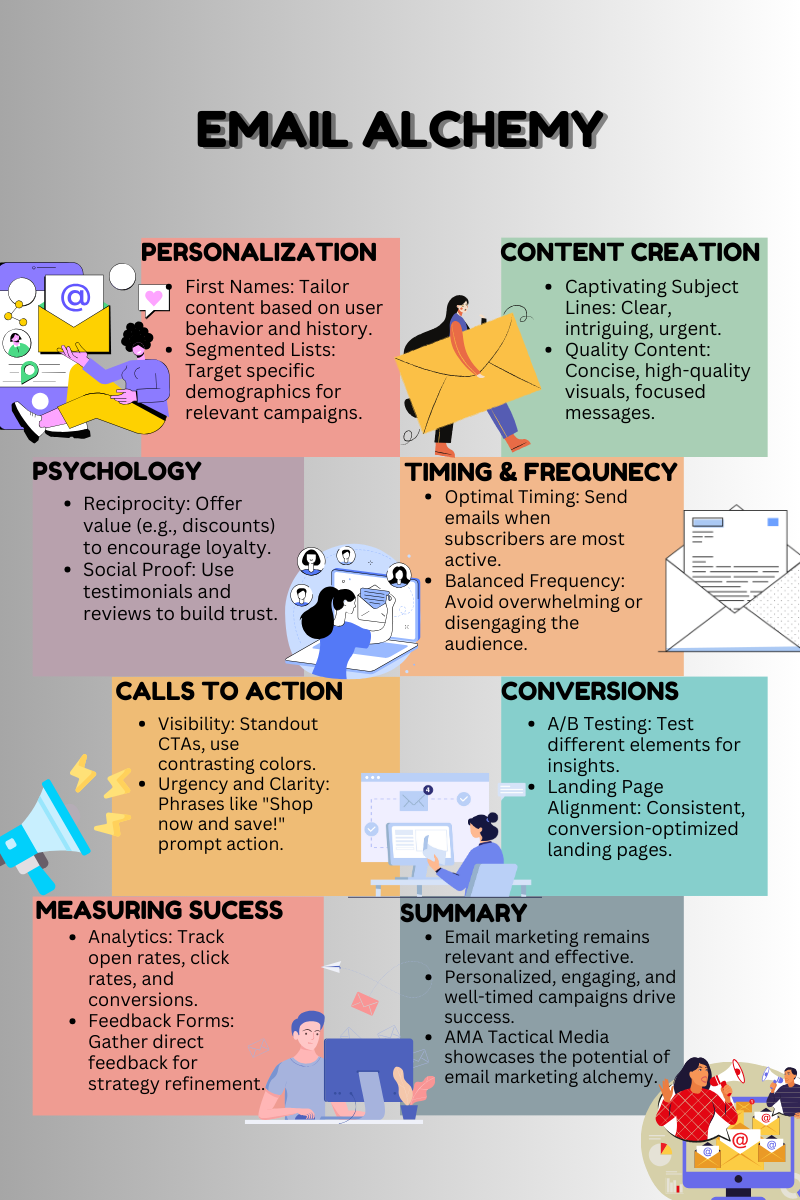
Article | Published:
Email Alchemy: Crafting Engagement and Conversion from Inbox to Sale
What is Email Marketing?
Email marketing remains one of the most effective strategies in the digital marketing toolkit, providing an incredible return on investment and a unique opportunity to connect directly with customers. Converting a simple email into a successful sale in the modern marketplace involves creativity, psychology, and strategic planning. This blog post explores the crucial techniques for mastering email alchemy, a journey that can significantly increase engagement and conversion from inbox to sale, empowering you to take control of your marketing success.
AMA Tactical Media has excelled in email marketing by employing personalized content, segmented lists, compelling subject lines, strategic psychological triggers, and optimized timing and calls to action, significantly enhancing engagement and conversion rates from inbox to sale.

What Does Personalization Mean in Email Marketing?
The Magic of First Names: Using a recipient’s first name is just the beginning. Advanced personalization involves tailoring the email content based on the user’s past behaviour, preferences, and purchase history. This approach shows recipients that the brand understands and values their unique needs and tastes, fostering a deep sense of appreciation and connection.
Segmented Email Lists: Segment your email list based on demographic data, purchase history, and user behaviour. For example, you can create a segment for customers who have made a purchase in the last 30 days and send them a ‘Thank you ’email with a special discount code for their next purchase. This allows for more targeted and relevant email campaigns, increasing the likelihood of engagement and conversion.
What is a Compelling Email?
Subject Lines That Captivate: The subject line is your first impression and main chance to grab attention. Effective subject lines are clear and intriguing and often include a sense of urgency or exclusivity.
Quality Over Quantity: The body of the email should be concise and focused. A clear message, high-quality visuals, and an easy-to-navigate layout can significantly boost engagement. Avoid overwhelming your audience with too much information or calls to action.
How Does Psychology play a role in Email Marketing?
The Principle of Reciprocity states that offering something of value for free (like a whitepaper, ebook, or discount code) can make recipients more inclined to give something in return, such as their attention, loyalty, or purchase.
Furthermore, including testimonials, customer reviews, and user-generated content can increase trust and influence purchasing decisions. People are more likely to buy a product if others like them have had positive experiences.
Timing and Frequency
Visibility: Your call to action (CTA) should stand out and be easy to find. Using buttons with contrasting colours and keeping them above the fold ensures they are noticed.
Urgency and Clarity: CTAs that create a sense of urgency or offer a clear benefit tend to perform better. Phrases like “Shop now and save!” or “Limited time offer” prompt immediate action.
Clear and Compelling Calls to Action
Optimal Timing: Sending emails at the right time can dramatically increase open rates and conversions. Analyze when your subscribers will likely check their email and schedule your sends accordingly. This strategic approach puts you in control, empowering you to maximize the impact of your email campaigns.
Frequency Matters: Too many emails can lead to what we call ‘subscriber fatigue ‘, where recipients become overwhelmed and start ignoring or unsubscribing from your emails. On the other hand, too few can make the audience disengage. Find the perfect balance by testing and analyzing the response to different frequencies.
Optimizing for Conversions
A/B Testing: Regular testing of different elements of your emails (like subject lines, content, and CTAs) can provide valuable insights into what works best for your audience.
Landing Page Alignment: Ensure that the landing page linked from your email is consistent in style and message. It should be optimized for conversion, with minimal distractions and a clear path to completing a sale.
Measuring Success
Analytics and Feedback: Use email marketing tools to track open rates, click rates, and conversions. This data is crucial for understanding the effectiveness of your campaigns and areas for improvement.
Surveys and Feedback Forms: Occasionally include a feedback form or survey in your emails. Direct feedback from subscribers is not just valuable, it’s crucial. It provides actionable insights and helps refine your strategy, making your audience feel included and valued in the process.
Conclusion
Email marketing is still relevant; it’s an evolving platform requiring a thoughtful approach to tap into its potential. By mastering the art of email alchemy, marketers can create powerful connections with customers, turning every email sent into a potential sale. As we continue to navigate the digital age, the importance of crafting personalized, engaging, and strategically timed email campaigns will only grow, solidifying email marketing as a cornerstone of effective digital marketing strategies.
Cite this article
Anthony, A. (2024, November 5). Email Marketing. AMA Tactical Media. https://amatacticalmedia.com/blogs/email-marketing/